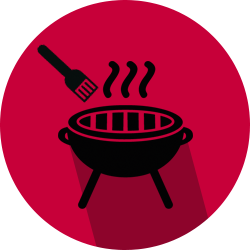Injuries related to barbecue brush bristle ingestion/inhalation:
Summary of statistics highlighting injuries related to barbecue brush bristle ingestion/inhalation.
- Last updated: 2024-05-07
Injuries related to barbecue brush bristle ingestion/inhalation continue to be a public health concern. This household item can pose a health risk to individuals, as metal bristles can detach from the brush and remain on the grill. If left unnoticed, these metal bristles can then be transferred to food and be consumed. Though rare, these injuries can result in serious health complications.
The numbers presented below are an updated analysis of such injuries using the Canadian Hospitals Injury Reporting and Prevention Program (CHIRPP) surveillance system. The original analyses appeared in the October 2017 issue of the Health Promotion and Chronic Disease Prevention journal (Volume 37 No. 10).

45 emergency department visits
Incidents are still being detected. Between April 1, 2011 and April 30, 2024, there were 45 reported cases of injuries related to barbecue brush bristle ingestion/inhalation, representing 2.2 cases per 100,000 CHIRPP records. Table 1 presents the annual distribution of such injuries captured in the CHIRPP database.
| Year | Count | Count per 100,000 CHIRPP records |
|---|---|---|
| 2011 | 1 | 1.1 |
| 2012 | 2 | 1.5 |
| 2013 | 1 | 0.7 |
| 2014 | 1 | 0.7 |
| 2015 | 1 | 0.7 |
| 2016 | 4 | 2.6 |
| 2017 | 8 | 4.8 |
| 2018 | 4 | 2.1 |
| 2019 | 8 | 4.3 |
| 2020 | 7 | 4.2 |
| 2021 | 3 | 1.4 |
| 2022 | 4 | 2.2 |
| 2023 | 1 | 0.7 |
Findings
- Overall, females represented 53.3% of cases (n= 24). There were 21 cases among males (46.7%).
- Of the 45 cases identified, 18 cases (40.0%) sustained injuries requiring hospital admission.
- Injuries related to barbecue brush bristle ingestion/inhalation affect all age groups (see Table 2).
| Age Group (years) | Count |
|---|---|
| 1 to 4 | 7 |
| 5 to 9 | 14 |
| 10 to 14 | 8 |
| 15 to 29 | 6 |
| 30 and over | 10 |

Four seasons
Injuries related to barbecue brush bristle ingestion/inhalation don’t just happen in the summer; they happen throughout the year.

Respiratory and digestive tract
Most injuries involved a metal bristle imbedding into an individual’s respiratory or digestive tract.

Sample Narratives
The actual number of individuals who have experienced injuries related to barbecue brush bristle ingestion/inhalation is unknown, as some might seek care at facilities other than emergency departments or might not seek care at all.
Sample narratives of the injuries reported to CHIRPP are listed below and are reported in the language of the patient’s own account of events. These include:
- Eating burger, found barbecue brush bristle in mouth, feels like one in throat.
- Patient ingested some pins from the BBQ brush.
- Eating barbecue pork, bristle from brush used to clean barbecue got lodged at base of tongue and adenoids.
- Eating BBQ food; metal bristle from BBQ brush stuck on food; bristle stuck in esophagus.
- Had barbecued hamburger, brush bristle lodged in throat.
Prevention
Caution should be exercised when using metal bristle barbecue brushes due to the potential health and safety risks associated with metal bristles detaching and adhering to grills or cooked food items. To minimize the risk of issues with your metal bristle barbecue brush:
- regularly inspect your brush for signs of damage
- inspect grills and barbecued food for loose metal bristles
- replace metal bristle barbecue brushes every season
- stop using your brush if metal bristles come loose or stick to the grill
- consider buying a non-metal bristle barbecue brush as there are now many new alternatives being offered by retailers
For more information on barbecue brush safety and recall updates, please visit Healthy Canadians.
Voluntary safety standard
In an effort to reduce the health risks associated with metal bristle barbecue brushes, Health Canada and the Retail Council of Canada commissioned the Standards Council of Canada to develop new national voluntary safety standards for such products. A public review of the draft safety standard was conducted in the summer of 2019 and the "CSA Z630:19 Barbecue grill brushes" standard was released in December 2019.
The "CSA Z630:19 Barbecue grill brushes" standard provides requirements for the performance, testing, and marking of hand-held barbecue grill brushes with metal bristles and replacement heads.
The standard specifies requirements for:
- wire bristle tuft attachment strength
- wire bristle durability
- replacement heads
- permanent on-product warning requirements
- requirements for instructional literature
Although the "CSA Z630:19 Barbecue grill brushes" standard is a voluntary standard, Health Canada and the Public Health Agency of Canada continue to monitor incidents and injuries due to metal barbecue grill brushes.
You might also be interested in
Lawn mower-related injuries
A summary of statistics highlighting lawn mower-related injuries.
Poisonings and injuries related to carbon monoxide exposure
A summary of statistics highlighting unintentional poisonings and injuries related to carbon monoxide exposure.
- Date modified:


